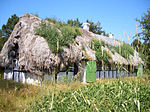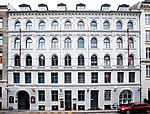
Christiansfeld, with a population of 2,985, is a town in Kolding Municipality in Southern Jutland in Region of Southern Denmark. The town was founded in 1773 by the Moravian Church and named after the Danish king Christian VII. Since July 2015 it has been a UNESCO World Heritage Site, highlighting its status as the best-preserved example of the town-planning and architecture of the Moravian Church.

Ilulissat, formerly Jakobshavn or Jacobshaven, is the municipal seat and largest town of the Avannaata municipality in western Greenland, located approximately 350 km (220 mi) north of the Arctic Circle. With a population of 4,670 as of 2020, it is the third-largest city in Greenland, after Nuuk and Sisimiut. The city is home to almost as many sled-dogs as people.
Sarfannguit is a settlement in the Qeqqata municipality in central-western Greenland. Its population was 96 in 2020. The settlement was founded in 1843. The town is located within the Aasivissuit – Nipisat UNESCO World Heritage Site, and is inscribed on the World Heritage List in 2018 for its outstanding archeological sites representing the human occupation of Greenland for over 4000 years.
Tourism in Greenland is a relatively young business area of the country. Since the foundation of the national tourist council, Greenland Tourism, in 1992, the Home Rule Government has been working actively with promoting the destination and helping smaller tourist providers to establish their services. Foreign travel agencies have increasingly been opening up sale of Greenland trips and tours, and the cruise industry has had a relatively large increase in routes to Greenland since about the turn of the century.

Ilulissat Icefjord is a fjord in western Greenland. Located 250 km north of the Arctic Circle, the Ilulissat Icefjord runs west 40 km (25 mi) from the Greenland ice sheet to Disko Bay just south of the town of Ilulissat. Ilulissat Icefjord was declared a UNESCO World Heritage Site in 2004 because of its natural beauty and the importance of the fast-moving Jakobshavn Glacier in developing the current scientific understanding of anthropogenic climate change.

Dorte Mandrup-Poulsen is a Danish architect. Founder and Creative Director of the architectural practice Dorte Mandrup Arkitekter A/S that has approximately 60 employees. The practice is based in Copenhagen, Denmark and is behind several internationally acclaimed buildings.






















